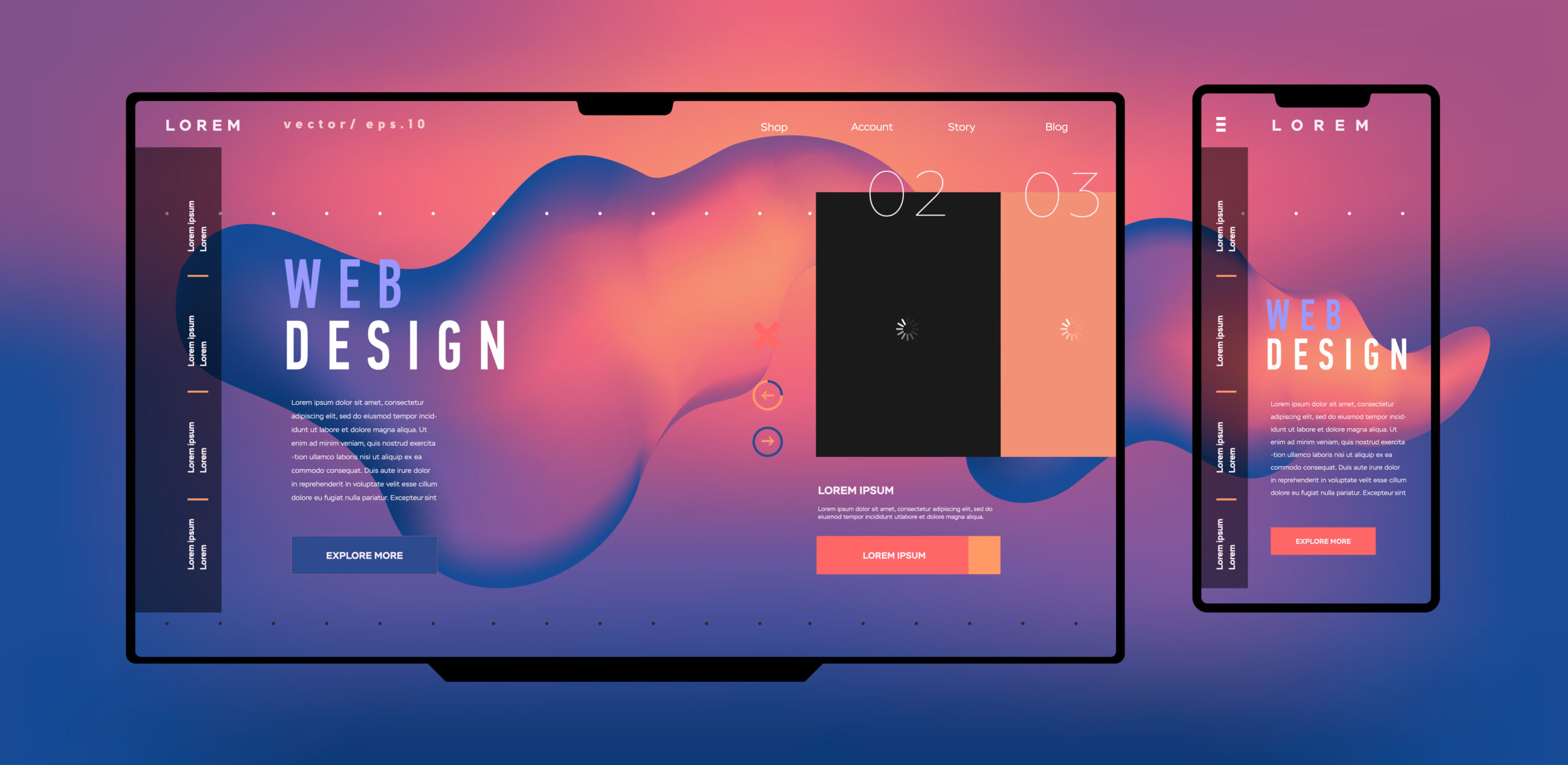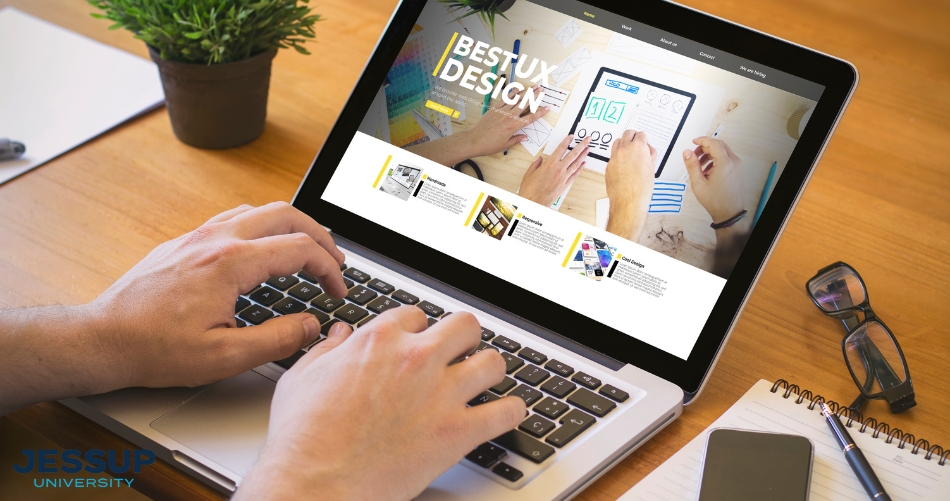Expert insights on creating engaging visuals from an agency for web design
Discovering Creative Trends in Web Design for Modern Organizations
The landscape of web design is consistently evolving, mirroring the vibrant requirements of modern organizations. Current patterns highlight a preference for minimalism, bold typography, and interesting interactivity. Companies increasingly prioritize user experience via mobile-first principles and personalized material. Additionally, a focus on sustainability is gaining grip. Recognizing these patterns is crucial for services intending to stand apart in a crowded industry. What effects do these changes hold for the future of digital interaction?
Accepting Bold Typography
Bold typography has actually arised as a defining aspect in modern web design, catching interest and conveying messages with striking clarity. This pattern prioritizes aesthetically impactful text that boosts user interaction and brand identification. Developers usually use one-of-a-kind typefaces and oversized typefaces to create a pecking order, directing visitors with content effortlessly.
The tactical use vibrant typography permits effective storytelling, making it possible for brand names to connect their values succinctly. It offers not only visual functions but additionally functional ones, as it improves readability across devices and screen sizes.
As internet sites compete for user focus, vibrant typography attracts attention in a saturated digital landscape. Its adaptability allows designers to trying out contrasting designs and colors, further intensifying its effectiveness. Ultimately, embracing vibrant typography stands for a shift towards even more expressive and communicative web design, fostering a much deeper connection in between brand names and their audiences.
The Rise of Minimalist Style
As digital settings end up being progressively messy, the rise of minimal layout provides an invigorating alternative that focuses on simplicity and performance. This style viewpoint strips away unnecessary aspects, enabling content to take center stage. By concentrating on tidy lines, enough white area, and a limited color scheme, minimal layout boosts user experience and improves navigation.
Companies adopting this pattern objective to convey their brand name message plainly and successfully, cultivating a sense of calm and clearness. The absence of diversions assists individuals focus on crucial information, leading to boosted interaction and conversion rates. Furthermore, minimalist layout straightens well with mobile-first techniques, making certain that internet sites remain easy to use and accessible across different devices.
Inevitably, the increase of minimal layout shows a broader change towards focusing on user requirements and choices, making it an effective tool for modern companies wanting to make a long-term effect in the digital landscape.
Immersive Animations and Interactivity
While lots of web designers accept minimalist looks, another engaging trend obtaining traction is the usage of immersive animations and interactivity. This method improves user involvement by producing interesting experiences that attract site visitors into the web content. Designers utilize vibrant elements such as animated histories, scrolling effects, and interactive infographics to connect complex ideas in an accessible manner.
These animations not just supply aesthetic rate of interest yet additionally guide customers via the navigation process, making interactions much more intuitive. Hover results and computer animated changes can motivate users to discover better, leading to raised time spent on the website.
This pattern lines up with the more comprehensive activity in the direction of storytelling in web layout, where animations serve as narrative tools that communicate brand messages properly. By incorporating immersive animations and interactivity, companies can differentiate themselves in a crowded online landscape, inevitably boosting user complete satisfaction and brand loyalty.
Mobile-First Layout Concepts
Mobile-first design principles highlight prioritizing user experience by ensuring websites work seamlessly on smaller sized displays. This method incorporates receptive format strategies that adjust to various gadget sizes while preserving aesthetic honesty. In addition, it focuses on touchscreen navigating layout, boosting use for mobile individuals.
Focusing On User Experience
How can designers properly prioritize user experience in an increasingly mobile-centric world? Stressing mobile-first design concepts is crucial, as users mostly engage with websites through mobile tools. This technique motivates developers to enhance web content, ensuring it is navigable and quickly accessible on smaller sized displays. Trick practices consist of streamlining navigation, lessening lots times, and employing touch-friendly elements that enhance interactivity. In addition, prioritizing legible typography and user-friendly designs can greatly improve user satisfaction. Designers ought to constantly gather user responses to improve their strategies, adapting to advancing user demands and choices. By concentrating on these aspects, services can produce an appealing digital experience that fosters loyalty and drives conversions, inevitably straightening with the assumptions these days's mobile customers.
Receptive Design Methods
Developers welcome receptive format strategies to produce flexible and adaptive web experiences that cater to numerous screen dimensions. This technique prioritizes mobile-first style concepts, making certain peak capability on smaller gadgets before scaling up for bigger displays. By utilizing liquid grids, flexible try here images, and media queries, designers can keep a natural visual identity throughout all systems. This technique not only enhances user interaction but also enhances search engine rankings, as mobile-friendly sites are favored by search formulas. Furthermore, receptive formats enable services to reach a broader target market, fitting users on smart devices, tablets, and desktop computers alike. In general, executing these methods is vital for modern web design, making certain that companies remain affordable in an ever-evolving electronic landscape.
Touchscreen Navigation Style
With the surge of smart phones, touchscreen navigating has become an essential facet of web design. Developers are progressively embracing mobile-first principles to boost user experience and interaction. web design company. Reliable go now touchscreen navigation prioritizes larger buttons and instinctive motions, allowing users to communicate easily with web content. This method minimizes irritation and encourages expedition, as users can browse seamlessly with their fingers. Additionally, integrating swipe motions and faucet functionality accommodates the natural actions of mobile customers. Comments devices, such as visual hints and computer animations, boost usability additionally by validating activities. As touchscreens dominate user communications, employing these layout components not just lines up with contemporary assumptions yet also promotes a more satisfying and easily accessible searching experience for all customers
Customized User Experiences
What makes a customer feel truly involved on an internet site? The solution often depends on customized user experiences. By tailoring material and navigation to individual preferences, organizations you could try this out can produce a meaningful link with their target market. This customization can be attained through various techniques, such as analyzing user habits, making use of cookies, and supplying personalized suggestions based on previous interactions.
Shopping platforms that recommend items based on searching history not only improve user experience but likewise increase conversion prices. Furthermore, incorporating vibrant web content that adapts to the user's area or time of day can further enhance involvement.
Furthermore, customized introductions or messages can make customers feel valued and comprehended. As contemporary businesses seek to stand out in a competitive digital landscape, embracing tailored user experiences ends up being vital, cultivating loyalty and encouraging repeat check outs. Ultimately, this technique changes a standard site right into an interactive system that resonates with its target market.
Sustainability in Web Design
As the electronic landscape remains to develop, the value of sustainability in web design has gained considerable focus. Developers are increasingly conscious of the environmental effect their developments can have, prompting a shift in the direction of environmentally friendly techniques (Web Design Agency). Lasting web design focuses on optimizing websites to lower power consumption and carbon footprints. Methods include using minimalistic design principles, optimizing photos, and employing efficient coding practices to boost loading speeds
Moreover, the selection of organizing companies plays a vital duty; many developers are now deciding for eco-friendly organizing services powered by renewable power. By prioritizing access and user-friendly navigation, lasting layouts also satisfy a more comprehensive audience, enhancing usability. This conscious method not just attract environmentally-minded consumers but additionally adds to the overall long life and performance of web sites. Inevitably, sustainability in web design reflects an expanding fad towards accountable digital methods that line up with modern company values.

Regularly Asked Concerns
How Can I Select the Right Color Pattern for My Web site?
To choose the right color design for an internet site, one should take into consideration the brand name's identification, target audience, and psychological effect. Utilizing color theory and testing mixes can improve user experience and visual allure substantially.
What Are the Ideal Tools for Prototyping Website Design?
The best devices for prototyping website design consist of Figma, Sketch, Adobe XD, and InVision. These systems offer instinctive interfaces, collaboration attributes, and substantial libraries, making them ideal for developers to produce and fine-tune their principles properly.
How Do I Determine the Effectiveness of My Web Design?
To measure web design efficiency, one must evaluate user interaction metrics, conversion prices, and use comments (Web Design Agency). A/B screening and heatmaps can additionally supply understandings right into user actions, guiding necessary adjustments for enhanced efficiency and user experience
What Are Usual Web Design Errors to Stay Clear Of?
Common web design errors consist of chaotic formats, bad navigation, slow-moving loading times, absence of mobile optimization, insufficient contrast, and disregarding user feedback. Preventing these mistakes boosts user experience and increases general performance of the site.
How Commonly Should I Update My Internet Site Style?
A website design need to be upgraded every 2 to 3 years, or faster if considerable changes in branding or technology take place. Normal updates keep the site fresh, functional, and straightened with existing user assumptions.
